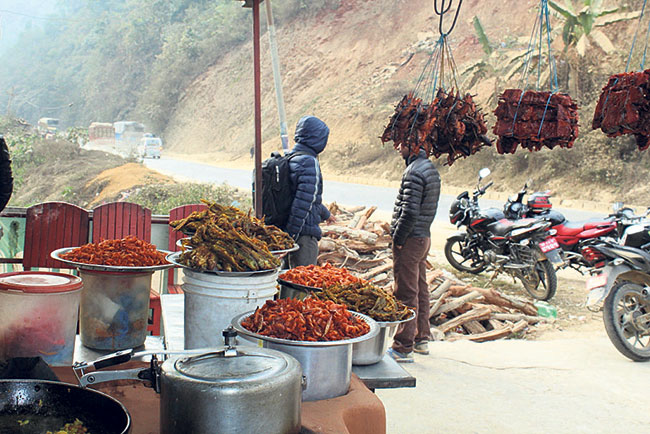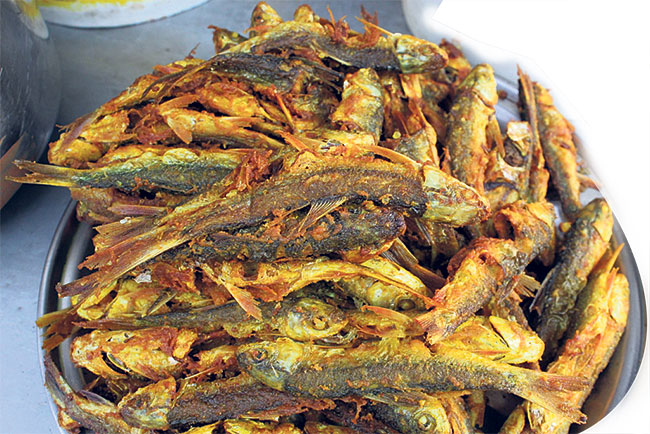DHADING, Feb 17:Malekhu of Dhading is a famous destination for fish lovers as thousands of people who travel through the Prithivi Highway stop their vehicles at Malekhu to have a taste of the local delicacy. It is said that the fish here taste better because they are fresh from the Trishuli River.
Though earlier only local fish were available in Malekhu, locals started to import them from various parts of the country, especially tarai, after the flood in 1993 destroyed the fish habitat. Visitors that come here to relish fish mostly prefer boneless fried fish during summer and soupy fish during winter season. The flow of people is mostly high during winter season. A local vendor Krishna Shrestha said “Eating fish during winter is considered good for our health so the business goes up during the cold days.” The price of dry fish starts at Rs 300, while the raw ones cost Rs 600 per pack.
Owing to low production, these days however, people barely get to taste the local fish from Trishuli in Malekhu. According to another local vendor Laxmi Magar, more than two to three tons of fish are imported daily in Malekhu due to the influx of people. As the fish business along the Prithivi Highway began to thrive, the then District Agriculture Development Office, Dhading had initiated different programs to make the district an independent source of fish.
Though there is no official data, it is said that the consumption of fish in Malekhu is more than its production. As the profit margin is better in fish business than in selling vegetables, the vendors often tend to sell both items at the time.
 First fish seller
First fish seller
Fish business in Malekhu was first started by Chabilal Marhattha in 2035 BS. Having started as a tea seller, he gradually grew his business into selling fish. His interesting journey has inspired many locals to follow his path.
He started the business suddenly one day when he saw a Chepang man fishing in the Trisuli River. Upon seeing that, he had an idea of selling fried fish. Gradually, the number of customers increased to such an extent that he had to request the Chepang fisherman to fish for him. These days about 15 quintal of fish and one quintal of potato is consumed daily in Malekhu.
Rehabilitated dacoit community returning to crime

SPICY FISH FRY
Fish fry recipe is so flavorful and delicious with spices. It is an easy and simple fried fish recipe to make in just a few minutes. Here’s the recipe and tips for the same:
Prep Time: 30 mins
Cook Time: 5 mins
Total Time: 35 mins
Servings: 10

Ingredients
2 lb Fish Tilapia Raw
2 tbsp Red Chili Powder
2 tbsp Coriander Powder
1 tsp Turmeric Ground
2 tsp Lemon Juice Raw
2 tbsp Cornstarch
0.50 cup Water
1 cup Oil
2 tsp Salt Table
Instructions
For marinade: In a bowl add red chili powder, coriander powder, turmeric powder, salt and mix well. Add lemon juice and mix well. Add water little by little and make a smooth paste. Cut the tilapia fillets and apply the marinade evenly on the fish. Marinate in the refrigerator for 20 minutes. In a separate bowl add corn flour, water and make a thin batter.
Heat oil in a pan and dip the marinated fish one by one in the batter and place in the hot oil carefully. Fry until the bottom side of the fish becomes crispy. Flip gently and fry on the other side until crispy. Line a plate with paper towel. Remove the fried fish from the oil and place on the paper towel-lined plate (this helps to absorb the excess oil from fish). Garnish with sliced onion and lemon if desired and serve.
Smart Cooking Tips:
Make the marinade separately instead of adding the spices directly on the fish. So that you can check for the salt and spice taste and adjust adding accordingly. Fry the fish in a hot oil over a medium to high heat. This helps to make a crispy fish fry. You can add other seasonings like ginger garlic paste, onion powder, garam masala and curry leaves. You can any variety of fish like salmon and catfish. If you are using frozen fish make sure to thaw the fish thoroughly before marinating. Wait until the bottom side of the fish becomes crispy before flipping to the other side. This helps to avoid the fish from breaking.
(Source: antoskitchen.com)


































